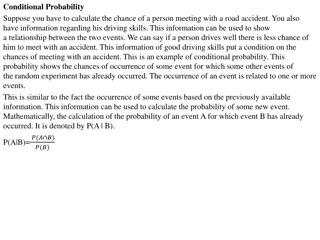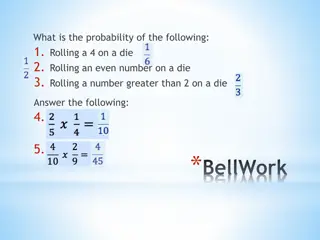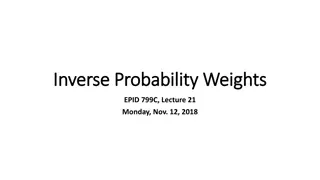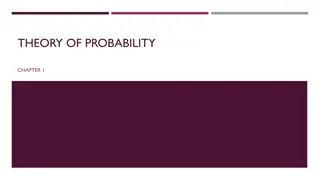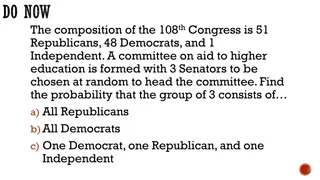
Thermodynamic Probability in Statistical Physics
Explore the concept of thermodynamic probability in statistical physics, where the number of microstates of a macrostate defines its probability. Learn how to calculate meaningful arrangements and the occurrence probability of different macrostates in a system of distinguishable particles.
Download Presentation

Please find below an Image/Link to download the presentation.
The content on the website is provided AS IS for your information and personal use only. It may not be sold, licensed, or shared on other websites without obtaining consent from the author. If you encounter any issues during the download, it is possible that the publisher has removed the file from their server.
You are allowed to download the files provided on this website for personal or commercial use, subject to the condition that they are used lawfully. All files are the property of their respective owners.
The content on the website is provided AS IS for your information and personal use only. It may not be sold, licensed, or shared on other websites without obtaining consent from the author.
E N D
Presentation Transcript
M S P Mandals Deogiri College, Aurangabad Department of physics Class :- B.Sc. S. Y.(sem:-lll) course:-Mathematical Statistical physics and Relativity chapter:- statistical basis and classical statistics Topic:- Probability Mrs. S.B.Patil
Thermodynamic Probability The number of microstates corresponding to any given macrostate is called its thermodynamic probability. In other words, the thermodynamic propability of a particular macrostate ls defined as microstates corresponding to that macrostate. In general, this is a very large number and is represented by W (or ) the number of
The number of microstates corresponding to a given macrostate is equal to the number of meaningful arrangements or permutations of various particles in the macrostate excluding those permutations which are meaningless i.e. merely interchange the order of particles in a particular compartment (or cell). For the case of n particles and two compartments (or cells), if r 5 the number of particles in the compartment No. 1 and the remaining (n-r) are in compartment No. 2, then No. of meaningful arrangements = n! /r! (n-r)! = n C r
Therefore, the number of microstates in a macrostate (r, n -r) or thermodynamic probability W(r,n-r) = n! /r! (n - r)! = n C r .(1) Applying this to a system of 4 distinguishable particles, for a macrostate (1, 3), r= 1, (n-r) =3 and n = 4 the number of microstates. (1, 3) or W(1,3) = 4! /1!3! =4 Similarly, for a macrostate (2, 2), r= 2,(n- r) = 2 and n = 4 the thermodynamic probability ie. no. of microstates will be W(2,2) = 4! /2!2! =6 and for macrostate (0, 4) or (4, 0) will be W(0,4) = W(0,4) = 4! /0!4!= 4! /4!=1 (0!=1) This agrees with the above table
Probability (P). The probability (or occurrence) of a macrostate is defined as the ratio of the number of microstates (i.e. thermodynamic probability W) in it to the total number of possible microstates of the system. Thus, Pmacro= No.of microstates in the macrostat Total no. of microstates of the system ..(2) The total number of ways of arranging n distinguishable particles inc numbered compartments = c n
If there are only 2 compartments or cells, then the total no. of microstates.of the system = 2 n.For 4 particles system, total no. of microstates will be 2 4= 16. From equation (2) we get. Pmacro =W/ c n =W/ 2 n Substituting for W from equation (1), P(r,n-r) = n! /r! (n-r)! x 1/ 2 n =1/ 2 n n C r This gives the probability (of occurrence) of macrostate (r, n-r).
combination Possessing Maximum Probability We know from elementary algebra that if n is even the value of n C r is maximum (greatest) when r=n/2refer table 9.2. Hence the maximum value of probability is given by Pmax =1/ 2 n n C n/2 = n! /(n/2) ! (n/2) ! x 1/ 2 = n! /[(n/2) !] 2 x 1/ 2 n combination Possessing Minimum Probability We know from elementary algebra that n C n is minimum, if r is equal to either zero or n. If r =0, the probability is Pmin = n! /r! (n-r)! x 1/ 2 n =n!/ 0!(n- 0)!x 1/ 2 n = 1/ 2 n .(i) (0!=1)
If r=n, the probability is Pmin = n! /r! (n-r)! x 1/ 2 n = n! /n! (n-n)! x 1/ 2 n = n! /n! 0! x 1/ 2 n (0!=1) = 1/ 2 n .(ii) Thus, from (i) and (ii), we conclude that the minimum probability is given by Pmin = 1/ 2 n
Relation between P and W The probability of occurrence of a particular microstate is given by P = 1/ 2 n because 2 n gives the total no. of microstates of a system of n particles to be arranged in two compartments (or cells) and all the microstates of a system have a priori probability. P=Wxp = No. of microstates in the macrostate x probability of occurrence of a microstate or P W Therefore the probability (of occurrence ) of macrostate (P) is directly proportional to the thermodynamics probability (W)
Division of compartments in to cells: In practice, if we wish to distribute n distinguishable particles in k compartments which are of unequal size, we find that the a priori probability of a particle going into a particular compartment is not the same. Large probability in a bigger compartment. This is because of unequal size of the compartment. This difficulty is over come by introducing the concept of a cell. Each compartment is divided into a very large number of sub- compartments, called as cells, in such a way that each cell is of the same size. Therefore, all the cells have the same a priori probability. The size of the cell is very very small and hence the number of cells in each compartment is exceedingly large. For a given size of the cell, the number of cells in each compartment is fixed.
Distribution of particles (incompartments of unequal size) The concept of a cell is well understood by considering the distribution of particles in different compartments marked as 1, 2, 3, -- i... K-1, k of unequal size (Fig. ) We wish to distribute n distinguishable particles in these k compartments. As the compartments are of unequal size, a priori probability of a particle going into particular compartment is not the same. To overcome this difficulty we introduce a concept of a cell. For this purpose we divide each compartment, from compartment 1 to k, into cells of equal sizes, so that compartment 1 contains g1 cells, compartment 2 contain, g2 cell compartment 3 contains g3 cells and so on, the ith compartment containing gi Cells and lastly kth compartment has gk cells.
as the compartments are of unequal size, the number of cells in each compartment will be different. The total number of cells, each of same size = g1 + g2+.......+ gi +..... gk = G Hence. (i) Since all the cells are of same size, there is an equal a priori probability i.e. a particle in a given compartment can go into any cell within the compartment with equal probability.
(ii) Moreover, since the size of the compartment is big, the number of cells in any Compartment are exceedingly large. Let us find number of ways of placing n1 particles in g1 cells for compartment 1. The first particle can go into any one of the g1 cells of compartment 1. Thus, the number of ways the first particle can be arranged in g1 cells is = g1 .
In M.B. Statistics*, as there is no restriction on the number of particles that can be placed in a single cell, the second particle can also go into any one of the g1 cells of compartment 1. Total number of ways in which two particles can be arranged in g1 Cells of compartment 1 is given by = g1 x g1 = g1 2 Proceeding in the same manner, the total number of ways in which n1 particles can be distributed in g1 cells of compartment 1 is = g1 x g1x g1 x..........x g1(n1 times) g1n1 The number of ways in which n1, particles can be chosen out of n Particles = nCn1 = n!/ n1!(n- n1)!
Therefore, the total number of ways in which n1 particles can be chosen out of n particles and placed in g1 cells of compartment 1 will be = n!/ n1!(n- n1)! X g1n1 let us find the number of ways of placing n2 particles in g2 cells of compartment 2 as under: the number of particles remain a after placing n1 particles in compartment 1 are =( n - n1). Out of these n2 particles are to be placed in g2 cells of compartment 2. The number of ways this can be done is = (n- n1)! / n2!(n- n1 -n2)! X g2n2
the total number of ways in which n1 Particles are distributed in compartment 1 and these n2 compartment 2 will be particles distributed in = n!/ n1!(n- n1)! X g1n1 X (n- n1)! / n2!(n- n1 -n2)! X g2n2 = n!/ n1! n2! (n- n1 -n2)! X g1n1 g2n2 Thus, the total number of ways of placing n particles in all the 1 to k compartments in such way that n1 , n2....... ni ,..... nk particles will go into the compartment numbered as 1, 2, ....i.. K resp.
i.e. the total no. o microstate in a Macrostate (n1 , n2,......... nk) is given by W(n1,n2,n3....nk)={n!/n1!n2!n3!...nk!(n-n1-n2-n3....nk)!}Xg1n1 g2n2 g3n3.... gknk But n- n1-n2-n3.....-nk = n-( n1 + n2 + n3........... + nk) = n-n=0 (n- n1-n2-n3.........-nk)!=0!=1 Thereore, W( n1,n2,n3......nk) = n!/n1!n2!n3!.... nkX( g1n1 g2n2 g3n3....... gknk ) or W = n!gini /ni! where denotes multiplication of terms stated above for various values of i. Thus, the concept of a cell plays an important role in overcoming the difficulty in the distribution of particles in different compartments of unequal sizes, keeping the consistency of the principle of a priori probability.


